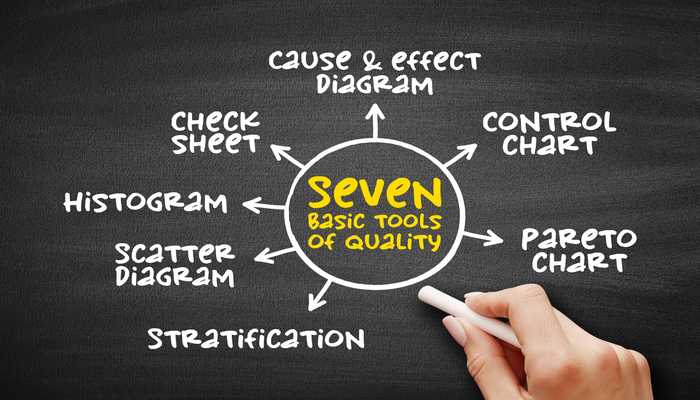Summary: One popular method employed is Total Quality Management (TQM) which integrates quality as an aspect of how an organization manages its operations, for long-term success. TQM, influenced by the teachings of quality experts, like Philip B. Crosby, Joseph M. Juran, and W. Edwards Deming goes beyond ensuring quality in the end product or service. It serves as a management framework that prioritizes improvement, customer satisfaction, and engaging all employees. By making quality a central focus companies can enhance their product and service standards increase efficiency and strengthen their edge. TQM creates a system where quality is emphasized at every stage from managing the supply chain to planning. The advantages of implementing TQM are numerous. It elevates product and service excellence, expands market presence and nurtures a culture of enhancement. The principles of TQM underscore the significance of quality management practices through guiding principles and foundational pillars.
Understanding Total Quality Management (TQM)
What is Total Quality Management (TQM)?
In essence, TQM is a philosophy that emphasizes quality as a core objective of an organization. It involves an approach, to overseeing quality across all processes and departments. TQM focuses on enhancement, customer satisfaction, and employee engagement to cultivate a culture of excellence.
Principles of TQM
TQM is shaped by guiding principles that organizations can adhere to to achieve excellence in quality;
- Customer Orientation; TQM prioritizes the customer in all endeavors to comprehend and meet their needs and expectations.
- Ongoing Improvement; TQM advocates for a culture of enhancement operating under the belief that there is always room for improvement.
- Employee Participation; TQM acknowledges the significance of involving employees at all levels in the improvement journey fostering a sense of responsibility and empowerment.
- Systematic Approach; TQM encourages organizations to see their operations as interconnected processes pinpointing areas, for optimization.
- Data Driven Decision Making; TQM relies on data and analysis to make decisions and steer improvement efforts.
- Benefits of Total Quality Management (TQM)Implementing Total Quality Management (TQM) can be highly advantageous, for organizations aiming to excel in today's market.
How can you achieve your TQM goals effortlessly?
An EQMS keeps quality on track!
Some key benefits of TQM include
1. Enhanced Quality and Productivity
By embracing TQM principles organizations can elevate the quality of their offerings and services. Through enhancement efforts, they can. Rectify flaws minimize wastage and boost productivity levels.
2. Improved Customer Satisfaction
Customer contentment is a factor in the prosperity of any business. TQM ensures that customer requirements are consistently met, resulting in heightened customer loyalty and positive recommendations.
3. Boosted Employee Engagement
TQM encourages employee participation and empowerment. When employees actively contribute to the enhancement process they feel valued and motivated leading to increased job satisfaction and efficiency.
4. Competitive Edge
Organizations implementing TQM gain an advantage. By maintaining a reputation for delivering top-notch products and services they set themselves apart from competitors. Draw more customers.
5. Strengthened Supplier Relationships
TQM underscores the importance of collaboration with suppliers cultivating relationships based on trust and mutual benefit. This fosters communication, quality assurance, and overall efficiency within the supply chain. Adopting TQM requires an approach along with unwavering commitment, from management. Organizations need to set forth a quality policy establish quality objectives and engage employees at all levels, in implementing Total Quality Management. By fostering a culture of quality and empowering staff organizations can promote improvement.
Ensure the successful execution of TQM
Key Components of TQM
TQM comprises components that contribute to its effectiveness. These components encompass quality control, quality enhancement, employee participation, and quality management systems. By integrating these elements into their operations organizations can establish a structure for delivering top-notch products and services.
Drawbacks of TQM
Despite the advantages that TQM offers it is crucial to recognize the drawbacks and obstacles linked with its implementation. Some common challenges include the requirement for time and resource commitments employee resistance to change and the danger of prioritizing quality over business goals. Nonetheless, with planning and management practices in place, these challenges can be overcome to achieve success through TQM.
Comparison of TQM, with Other Quality Management Approaches
TQM is often contrasted with quality management methods like Six Sigma and Lean. While each approach has its features they can work together harmoniously with TQM. For example, Six Sigma concentrates on reducing defects and variations whereas Lean strives to eliminate process waste. By combining TQM with these strategies organizations can achieve an integrated approach to managing quality.
Future Trends in Total Quality Management
As business practices and technologies progress so does the evolution of TQM. The upcoming trends in TQM involve the adoption of quality management practices a focus on data-driven decision making and the integration of TQM with emerging technologies such as artificial intelligence and automation. Keeping abreast of these developments and embracing them can assist organizations in staying competitive and upholding their dedication to quality standards.
FAQ | Total Quality Management (TQM)
What is Total Quality Management (TQM)?
TQM is a management approach focusing on achieving quality excellence in all aspects of an organization’s operations. It involves a systematic and integrated approach to managing quality, utilizing quality management tools to meet or exceed customer expectations and drive continuous improvement.
Why is TQM important in modern business practices?
It is essential because it helps organizations deliver high-quality products and services, increasing customer satisfaction and loyalty. A well-implemented quality management system (QMS) supports these efforts by standardizing processes, ensuring compliance with industry regulations, and fostering continuous improvement. Additionally, TQM enhances efficiency, reduces costs, and improves overall organizational performance.
What are the fundamental principles of TQM?
Fundamental principles include a strong focus on customer satisfaction, a commitment to continuous improvement, employee involvement and empowerment, a systematic approach to quality management, and using data and facts for decision-making.
How can TQM be implemented in an organization?
Implementing Total Quality Management (TQM) requires a structured approach. It starts with top management commitment and involvement. Organizations must establish a clear quality policy, define quality objectives, involve employees at all levels, and create a quality culture. Continuous improvement efforts and the use of an electronic quality management system (eQMS) are essential for streamlining processes, ensuring compliance, and enhancing overall quality performance.
What are the benefits of implementing TQM?
The benefits of implementing it include improved customer satisfaction, increased productivity and efficiency, reduced costs and waste, enhanced employee morale and engagement, better decision-making based on data, quality compliance, and a competitive advantage in the market.
Are there any disadvantages or challenges associated with TQM?
Yes, there can be challenges in implementing it. Some common challenges include the need for significant time and resource investment, resistance to change from employees, and the risk of overemphasizing quality management at the expense of other business priorities. However, these challenges can be overcome with proper planning, communication, and employee involvement.
Are there any real-life examples of successful TQM implementation?
Yes, many organizations have successfully implemented TQM. Some well-known examples include Toyota, Motorola, and Ford. By adopting TQM principles and practices, these companies have significantly improved quality, customer satisfaction, and overall performance.
Image: Adobe Stock – Copyright: © Annika – stock.adobe.com





